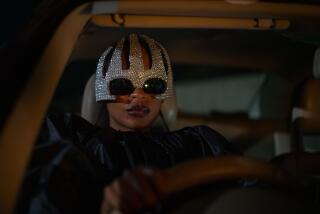True-life tales don’t come any truer
- Share via
Toronto — FILMMAKERS are suckers for a true story. It feels like most of the movies I’ve seen at the Toronto Film Festival this year are based on, inspired by or somehow fueled by a true story. Once you get directors talking, they’re always boasting about how much research and reportage they’ve done on their true-life characters.
And then there’s Phillip Noyce, the veteran Australian director whose new film, “Catch a Fire,” has been one of the marvels of the festival. Due out in October from Focus Films, “Catch a Fire” is an emotionally charged thriller about Patrick Chamusso, an apolitical South African oil refinery foreman who, after being tortured by government terror squads, becomes a freedom fighter for the African National Congress in its battle to topple South Africa’s repressive apartheid regime.
When it comes to authenticity, the director doesn’t have to brag about how much time the real Chamusso spent visiting the set helping coach Derek Luke, who plays him in the film, or showing the movie’s extras how to dress, talk and dance like 1980s-era South Africans. Noyce simply introduces me to two women seated in his hotel suite: Shawn Slovo, the film’s screenwriter, and Robyn Slovo, one of the film’s producers. “For those two, it’s a family story -- they’ve lived it their whole lives,” says Noyce, a big bear of a man whose previous films include “Patriot Games” and “The Quiet American.”
Shawn and Robyn’s roots in the anti-apartheid movement run deep. Their father was Joe Slovo, who headed the military wing of the ANC and was the man who trained Chamusso to be a freedom fighter. Robyn is seen in the movie, playing her mother, Ruth First, an ANC political operative who was assassinated in 1982 by apartheid supporters. (Shawn fictionalized the parents’ story in her screenplay for the 1988 film “A World Apart,” with Barbara Hershey playing the sisters’ mother.)
When Noyce was filming in South Africa last year, the Slovo name opened a lot of doors. “The family connection was key in the making of the film,” Noyce says. “Imagine you want to film the story of the man who tried to sabotage South Africa’s biggest oil refinery -- and actually shoot it at the refinery where it took place. I never thought it would happen until a Slovo sister made a call to someone highly connected in the government. Boom! We’re totally welcome to film wherever we like.”
Shawn spent much of her life in exile in England while her father trained special-operations sabotage units in Mozambique. After Nelson Mandela came to power, her father introduced her to Chamusso, who told her his story, which became the basis for the film. When Noyce came on board, he traveled around South Africa, using a digital camera to film all the places where the story takes place. He edited the footage down to 90 minutes and gave it to Shawn, telling her, “Here’s my script notes.”
In other words, Noyce wanted to stick as close to real events as possible. Noyce recalls taking Chamusso to the refinery he tries to dynamite in the movie. “It was a classic example of things he did that you wouldn’t dare make up,” Noyce explains. “He described how he was able to penetrate a cordon of army and police by going underground through the mines, then riding into the plant itself on a conveyor belt going 50 mph, all with liquid explosives strapped to his body.”
Noyce laughs. “That’s something straight out of a Tom Clancy movie -- but it was true! So we put it into the movie. There are some events in the film that occur in a different order or characters that go by different names, but everything in the movie actually happened.”
Some of the most moving scenes in the film feature freedom songs that South Africans would sing for solace and hope during the worst years of oppression. Bob Marley’s reggae music was also popular at the time in South Africa, which led in part to the film taking its title from one of his albums. The movie was originally called “Hot Stuff,” after Chamusso’s ANC code name. “But when we first tested the film, it was obvious that title was quite a barrier,” Noyce says. “We finally got a long list of names and picked ‘Catch a Fire.’ It seemed so evocative and because it was a Marley song, it felt right, since so much of his music was about a struggle for freedom.”
Noyce says he was most in awe of how the South African freedom fighters, once they overturned apartheid, so rarely sought revenge, even though many of them had been jailed and brutally tortured. “What stays with me about Chamusso is that he has a resilience and a lust for life that seems typical of the South African spirit,” Noyce says. “His determination was fueled by his passion for freedom and his love for life.”
For me, the film’s most moving moment comes when Chamusso confronts the South African security branch policeman who had tortured him and tried to break his spirit. In words that must have had a deep resilience for Shawn Slovo, who saw her parents endure a similar struggle, Chamusso tells his adversary, “My children will say, ‘He stood up for what is right.’ What will your children say about you?”
The Big Picture is at the Toronto Film Festival this week. To see more coverage, go to latimes.com/toronto.
More to Read
Only good movies
Get the Indie Focus newsletter, Mark Olsen's weekly guide to the world of cinema.
You may occasionally receive promotional content from the Los Angeles Times.








